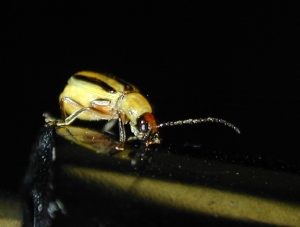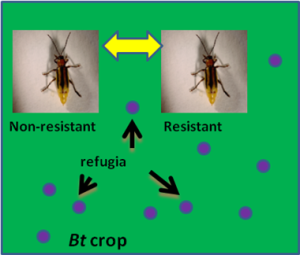Written by Stephanie Gorski
Hi, I started this series to explain a little more background behind the news and opinion articles you may have seen about Bt-resistant corn rootworms, with scary titles like Voracious worm evolves to eat biotech corn engineered to kill it and Evolution one-ups genetic modification. I started out talking about the system as it was originally developed for moths, but I wanted to come back to talk about why rootworms are so good at developing resistance to Bt crops. Part I of this article talked about refuges and how they are used to slow insect resistance, so I’m assuming you know how a refuge works. If you don’t, check out Sex and death in the cornfields: What is a refuge?

There are several different pestiferous species of rootworms, but they are often lumped together because their larvae are difficult to tell apart. The Western corn rootworm (Diabrotica virgifera virgifera) is the most damaging and most studied.
As you may recall, transgenic Bt-expressing corn targeting rootworms has only been around since 2003, and there are already reports of resistance. Resistance has been confirmed in Iowa. Reduced susceptibility has been reported in Colorado, Minnesota, Nebraska, and South Dakota. (Reduced susceptibility is basically the same idea as resistance, but is defined more loosely; there is a lower standard of evidence to meet.) So it looks like there will be more resistance occurring in the near future.
It looks like we haven’t been as effective in slowing resistance development with rootworm-active transgenics as with moth-active transgenics. Why? There are lots of things about the rootworm system that make it less simple and less elegant than the moth system.
Rootworms as resistance machines
Rootworms are really good at what they do- which, among other things, is developing resistance to stuff. The first report of rootworm resistance to pesticides I could find was in 1959 (Ball and Weekman 1962). They’ve even developed resistance to crop rotation (Onstad et al. 2001), as you may recall from the last article.
We’re not really sure why rootworms are so good at resistance development, but the lab of Dr. Marce Lorenzen is currently working on creating transgenic rootworms for use in laboratories. These transgenic rootworms can be used as tools to learn more about resistance genes in rootworms.
High dose
To make matters worse, rootworm-active transgenic Bt corn is not high dose. In the last article, I talked about how high dose meant that Bt toxin was expressed at such a high rate that the offspring of a resistant and a susceptible insect would probably not survive to pass on its genes. The important thing to remember is that high dose “forces” a resistance gene to act like a recessive gene. This means that having a single (heterozygous) resistant gene won’t give the insects a survival advantage, so spread of the resistant gene will be a lot slower.

Unfortunately, we don’t have any high-dose rootworm-active transgenic Bt corn available. And research has shown that resistance by rootworms is inherited dominantly, not recessively (Petzold-Maxwell et al. 2012). So the offspring of that resistant and susceptible insect will survive- and pass on that resistant gene.
Dispersal
For another thing, rootworms are just physically and behaviorally different than moths. If you remember our refuge diagram, it’s important that an adult resistant moth find a susceptible mate from the refuge so that they can mate and produce heterozygous offspring. But that means that the adult resistant moth has to actually fly over to the refuge area and find a boy/girlfriend (or vice versa). What if the moth had to walk instead of fly?
Rootworms are beetles, and beetles aren’t as strong flyers as moths. Most female rootworms won’t fly before they are mated. So a resistant rootworm may just hang around the transgenic field until he/she finds a mate there instead of checking out the refuge field. That means that a resistant rootworm from a Bt field will be more likely to mate with another resistant rootworm than with a susceptible rootworm from a refuge. So her kids will have two resistant genes instead of one.

Sublethal dose
Some smart people came up with a solution to the dispersal problem. (They always do, don’t they?) Instead of having blocks of non-Bt plants next to a Bt field, they intersperse non-Bt seeds randomly throughout the field. So the refuge might be a single plant over here, a single plant over there, etc.
But this has its own set of problems. Because non-Bt plants are located conveniently next to Bt plants, larvae might move from plant to plant as well as adult. In the field, rootworm larvae congregate around non-Bt plants (Rudeen and Gassman 2012). What if a rootworm moves from plant to plant during the course of its development? It might receive some toxin, but not enough to kill it. Sublethal doses of a toxin are a good way to develop resistance (Mallet and Porter 1992)- just as a little poison might not kill you.
Are these resistance reports the end of the world?
No. At its very worst, insect resistance means that a tool we are using is no longer useful. It happens to all pest management solutions, not just transgenic ones. This continual reliance on more/newer pesticides just to get the same job done is sometimes called the “pesticide treadmill”, and it’s what insect resistance management (like refuges) was designed to combat. It’s sort of analogous to what you may have heard about antibiotic-resistant bacteria.
We do want to preserve this technology as long as possible, though.
Experts say that when a field appears to have resistant rootworms, it probably has a few identifiable traits: It is not rotated; the same Bt trait is used year after year; sometimes the farmer did not comply with refuge requirements. So as is often the case, simply using best management practices can slow the spread of resistance. Of course, this can be easier said than done- most farmers already rotate, but if a farmer doesn’t rotate his/her crops, it’s probably not because he/she just likes breaking rules or doesn’t know. There are economic pressures that influence farmer decisions, and different crops require different equipment that the farmer may not have.
Rootworm-active Bt corn still works in most locations. Traditional methods also work. Crop rotation works in most places, as do seed treatments and insecticide applications. There’s a nice article summarizing rootworm control methods available for farmers here.
More recent rootworm-active Bt transgenic corn is stacked, meaning that there are multiple transgenes of interest expressed in a single corn line. For our purposes, “stacked” means that there are multiple rootworm-active Bt proteins incorporated into the same corn line. The reason stacking multiple rootworm-active genes together is important is that it can be more difficult for a pest population to develop resistance to multiple strains of Bt at once. Think of a lottery ticket- it’s not that hard to get one number right, but it’s much harder to get six numbers right!
Corn lines from just a few years ago contained only one or two rootworm-active Bt genes, but newer corn lines include several. A few years ago, scientists engineered a new Bt protein active against rootworms, eCry3.1Ab, by combining two Bt proteins that were active against moths! Because eCry3.1Ab is still pretty new, no resistance has yet been reported, but it is already being used.
New technologies are being developed that use methods other than Bt to target rootworms, such as RNAi. There are still a few kinks to work out, but it’s already been shown that RNAi technology can kill larval rootworms. I personally am looking forward to some new technologies!
Works Cited
- Ball, H. J. and Weekman, G. T. (1962). Insecticide resistance in the adult western corn rootworm in Nebraska. J. Econ. Entomol., 55 439-41.
- [EPA] Environmental Protection Agency (2014) White paper on corn rootworm resistance monitoring for Bt plant-incorporated protectants. Available from http://www.regulations.gov/#!documentDetail;D=EPA-HQ-OPP-2013-0490-0008
- Gassmann A, Petzold-Maxwell J, Keweshan R, Dunbar M (2011) Field-evolved resistance to Bt maize by Western corn rootworm. PLoS one 6(7): e22629.
- Mallet J, Porter P (1992) Preventing insect adaptation to insect-resistant crops: are seed mixtures or refugia the best strategy? Proc. R. Soc London, 250(1328): 165-169.
- Onstad D, Spencer J, Guse C, Levine E, Isard S (2001) Modeling evolution of behavioral resistance by an insect to crop rotation. Entomologia Experimentalis et Applicata 100(2): 195-201.
- Petzold-Maxwell J, Cibilis-Stewart X, French B, Gassmann A (2012) Adaptation by Western corn rootworm (Coleoptera: Chrysomelidae) to Bt maize: inheritance, fitness costs, and feeding preference. J. Econ. Entomol. 105(4): 1407-1418.
- Rudeen M, Gassmann A (2012) Effects of Cry34/35Ab1 corn on the survival and development of western corn rootworm, Diabrotica virgifera virgifera. Pest Manage. Sci. 69(6): 709-716.
- Vaughn T, Cavato T, Brar G, Coombe T, DeGooyer T, Ford S, Groth M, Howe A, Johnson S, Kolacz K, Pilcher C, Purcell J, Romano C, English L, Pershing J. (2005) A method of controlling corn rootworm feeding using a Bacillus thuringiensis protein expressed in transgenic maize. Crop Science 45(3): 931-938.
Written by Guest Expert
Stephanie Gorski has a PhD in entomology from North Carolina State University. She has a strong interest in environmental sustainability and conducted research on Western corn rootworm and transgenic Bt crops. She is currently an Assistant Professor at Wiley College.
Thanks, I appreciate the way you followed up. Seems there is a lot to learn from these grubs.
LikeLike
Thank you for all the info. You could put up the links for the previous parts though.
LikeLike